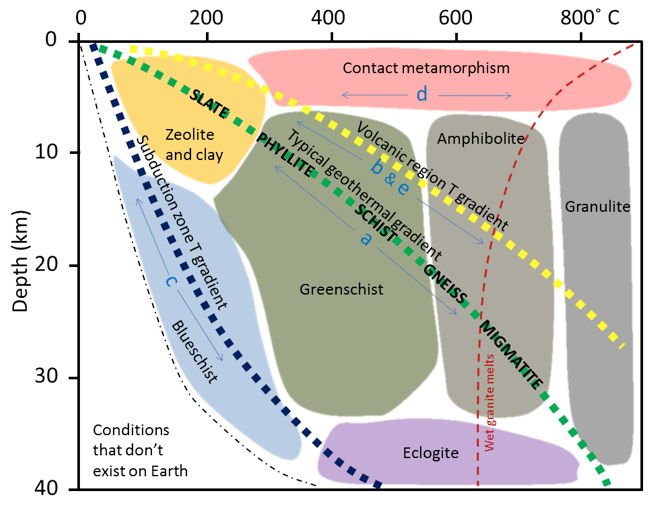Chapter 10 Summary & Key Term Check
Chapter 10 Main Ideas
10.1 Controls on Metamorphic Processes
Metamorphism is controlled by five main factors: the composition of the parent rock, the temperature to which the rock is heated, the amount and direction of pressure, the volumes and compositions of fluids that are present, and the amount of time available for metamorphic reactions to take place.
10.2 Foliation and Rock Cleavage
When the pressure acting on a rock is not uniform in all directions, foliation can develop. Foliation may occur in the form of platy or elongated mineral crystals that have grown at right angles to the maximum pressure, or it may develop when crystals or clasts within a rock are deformed. Foliation causes crystals or clasts within a rock to become aligned. When metamorphic rocks break parallel to the direction of foliation, rock cleavage results.
Practice Again
10.3 Classification of Metamorphic Rocks
Metamorphic rocks are classified on the basis of texture and mineral composition. Foliation is a key feature of metamorphic rocks formed under directed pressure; foliated metamorphic rocks include slate, phyllite, schist, and gneiss. Metamorphic rocks formed in environments without strong directed pressure include hornfels, marble, and quartzite.
Practice Again
10.4 Types of Metamorphism and Where They Occur
Almost all regions that experience metamorphism are being acted upon by plate-tectonic processes. Oceanic crustal rock can be metamorphosed near the spreading ridge where it was formed. Regional metamorphism takes place in areas where mountain ranges are forming, which are most common at convergent boundaries. Contact metamorphism takes place around magma bodies in the crust, which are also most common above convergent boundaries. Shock metamorphism happens when extraterrestrial bodies impact Earth, and is unusual among metamorphic processes because it occurs in seconds or minutes, rather than taking millions of years. Dynamic metamorphism occurs when shear stress is applied to rocks, such as along faults.
Practice Again
10.5 Metamorphic Facies and Index Minerals
Metamorphic facies are groups of metamorphic rocks that form under the same range of pressure and temperature conditions, but from different parent rocks. Geologists use index minerals such as chlorite, garnet, andalusite, and sillimanite to identify metamorphic zones. Index minerals tell us about the pressure and temperature conditions under which metamorphic rocks formed.
Putting It Together: Using Metamorphic Grade & Index Minerals to Solve a Mystery
You have four samples and a mystery on your hands…
You’re so lucky! Your friend went on a hike through an eroded mountain range and brought some rocks back for you. Well, maybe not quite so lucky… your friend knows which locations he collected samples from, but didn’t record which sample came from where. Now you have four samples and a mystery on your hands.
Your friend provided you with a sketch of the sampling locations (below), and penciled in the original shape of the mountain range before erosion happened. The sketch shows that sample sites 1 through 4 start from the edge of the mountain range and move toward its core, in the direction of increasing metamorphic grade.
Can you use this sketch and the sample descriptions to figure out which sample came from each location? Two reference diagrams are provided below, should you need them.

Write the correct sample location number in each box.
Schist consisting predominantly of biotite, with minor garnet
Migmatite, a rock with dark and light layers folded and twisted into convoluted shapes
Slate, a fine-grained rock with nearly planar rock cleavage
Schist consisting predominantly of chlorite
To check your answers, navigate to the above link to view the interactive version of this activity.
Mineral Stability Ranges

10.6 Metamorphic Hydrothermal Processes and Metasomatism
Contact metamorphism takes place around magma bodies that have intruded into cool rocks in the crust. Heat from magma is transferred to the surrounding country rock, resulting in mineralogical and textural changes. Hot water from a cooling body of magma, or from convection of groundwater driven by the heat of the pluton, can lead to hydrothermal alteration. When large volumes of fluid are flushed through rocks experiencing metamorphic pressures and temperatures, metasomatism results. Metasomatism can cause valuable metals to accumulate in the surrounding rocks.
Practice Again
Key Term Check
What key term from Chapter 10 is each card describing? Turn the card to check your answer.


